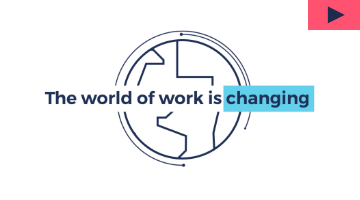Future of work
How is technology changing the world of work today?
From apps that enable crowdworking to data analytics tools that map employee behaviours, our working lives are becoming more tech -enabled. So what are the opportunities – and where are the risks?
The rise of the ‘gig economy’ is reshaping the traditional employer/worker relationship.
In some instances, non-standard forms of employment enable more workers to enter the labour market, in others, they pose challenges in relation to working conditions and the performance of companies.
‘Non-standard’ forms of employment include temporary employment; part-time and on-call work; temporary agency work and other multi-party employment relationships; as well as disguised employment and dependent self-employment.
An important component of the platform economy is digital labour platforms which include both web-based platforms, where work is outsourced through an open call to a geographically dispersed crowd (‘crowdwork’), and location-based applications (apps) which allocate work to individuals in a specific geographical area.
At the same time, big data and people analytics tools are playing an increasingly important role in HR decision-making. Alongside the benefits, these developments raise a number of challenges for business.

Data ethics… is similar to the dawn of the environmental movement. We are beginning to wake up to the downsides of this amazing resource called data that everybody loves to compare to oil or gold.
|
Pernille Tranberg |
How does crowdworking work?
Typically, a requesting organisation will post tasks on web-based platforms maintained by intermediaries. Crowdworkers can choose to complete the tasks that have been posted. Contractual relationships may exist between the requesting company and the intermediary, the crowdworker and the intermediary, or at times the requesting company and the crowdworker. The legal debate around crowdworking focuses on whether it undermines worker protection and social security; and whether crowdworkers qualify as freelancers or as employees.
Innovative working practices
Alongside these trends, new products are increasingly developed using agile methodologies such as ‘scrums’.
Scrum work revolves around autonomous, flexible, non-hierarchical teams (or ‘squads’) that work without specific instructions and often operate independently of the main business.
Employees can frequently switch between squads at short notice, resulting in a change in their working conditions. They might be required to go to a different location, work different hours or even operate in a different language.
This raises a number of HR issues and, in some cases, legal risks.
It can be hard to assess how an individual is doing when they work as part of a scrum, which in turn can raise challenges around incentivisation. Bonuses, for example, may need to be based on team, rather than individual, performance, which may require existing arrangements to be amended or new ones to be put in place. In some jurisdictions, frequent changes to working conditions may require the consent of the individual or consultation with employee representatives.
New working structures and reporting lines
Digital transformation often brings with it a reorganisation of working structures, for example the replacement of traditional chains of command with matrix regimes, or the implementation of parallel reporting lines (this is often the case when new practices such as scrum working are introduced).
Changes like these may result in employees having solid and dotted reporting lines to different parts of the business. They may have one reporting line to the manager in charge of HR (eg for holiday approvals, appraisals and disciplinary matters) and others to managers responsible for their day-to-day activities. They may have to report to a different office, country or even corporate entity.
Again, implementing changes such as these may require the business to seek individual consent or engage with employee representatives.
Employee monitoring
People analytics is one of the hottest trends in HR. At a high level, people analytics involves the application of digital tools and algorithms to data about or relating to people, with the aim of extracting actionable insights aligned with the company’s goals, such as higher revenues and/or lower costs.
Examples available today include systems that:
- analyse emails to determine what mood people are in;
- listen to and analyse voices to determine the honesty of someone’s statements (eg in a job interview);
- match employees with upcoming or vacant roles based only on their skill sets, removing subjectivity;
- assess the likelihood of a team meeting its corporate targets year on year, thus allowing them to be adjusted to be appropriately stretching;
predict which new joiner (or job applicant) will be a top performer; - show real-time correlations between coaching and engagement;
- highlight that a specific team is communicating only with some departments and neglecting others, which may give managers the opportunity to open communication channels and improve business efficiency;
- calculate the amount of time workers should spend carrying out a specific task and measure their productivity, for example via wearable devices that track employees’ movements at work and monitor their performance; or
- analyse hourly labour and immediately identify patterns of overtime and other forms of payroll leakage, enabling improvements in workforce management and planning.
Despite the advantages, people analytics tools must be used with care because tracking employee movements may in some jurisdictions be classed as illegal surveillance. In addition, Germany has a specific provision that grants works councils a co-determination right with respect to new technologies that can monitor/assess employees.
The EU’s General Data Protection Regulation includes rules to protect individuals from ‘solely automated decision-making’ that has ‘legal or similarly significant effects’. This type of decision-making can only be carried out where the decision is:
- necessary for the entry into or performance of a contract; or
- authorised by EU or member state law applicable to the data controller; or based on the individual’s explicit consent.
Businesses must also be alive to AI’s potential for bias. If recruitment algorithms, for example, are built on flawed data or faulty models, they may put the company in breach of anti-discrimination laws.
